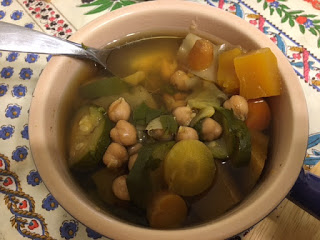Growing up in Israel, I enjoyed lots of Iraqi food: I especially loved sabich, the special sandwich with fried eggplant and tahini, which is delicious and easy to make. But today, as part of our Banned Countries food tour, we’re making something a bit more elaborate: Maklouba.
I was taught how to make maklouba many years ago by one of my clients, who was doing a life sentence at an Israeli prison. He was vegetarian, and received dispensation from the prison authorities to make his own food. He would get an allowance for some cheap vegetables, cut them up, fry them, and then layer them with rice to produce this fragrant, delicious cake. Making his own food made him feel just a bit freer and more independent than he was, and helped his spirit soar under difficult external and internal circumstances.
This version is a bit different than the traditional: rather than frying all the vegetables, I slice and pre-bake them on a silpat mat, reducing the overall fat content and oxidation of the dish without missing out on the taste. I also include more vegetable layers, because anything is better with more colorful layers!
1 medium eggplant
1 butternut squash
1 medium-sized potato
1 golden beet
1 large carrot
1/2 medium cauliflower
1 onion
3 roma or beefsteak tomatoes
1 cup brown rice
2 cups water or vegetable broth
1 tbsp baharat
1 tbsp ras-el-hanout
Heat the oven to 375 degrees. Slice all vegetables into 1/4-inch thick rounds. Place all of them, except the tomatoes, on baking sheets, drizzle a bit of lemon juice or vegetable broth, and bake for about 20 mins or until eggplant is soft.
Coat the bottom of a Dutch Oven with a circle of parchment paper, and atop it, place the tomato slices in a layer. Don’t be afraid to overlap.
Remove vegetables from oven. Place layer of eggplant rounds atop the tomato. From here on, the layering is up to you! I continued with onion, beet, and carrot, then put a layer of rice, and then did a second layer of squash, potatoes, and cauliflower, and placed the rest of the rice. Whatever you do, aim at finishing with a layer of rice.
Mixing the spices into the water or broth, gingerly pour it on top of the layers, without disturbing the architecture of the thing. Place on stove and cook on high heat until water boils, then lower the heat and let simmer for about 30-35 minutes or until rice on top is ready.
To eat, place a sturdy plate, inverted, atop your pot. Carefully invert the pot and place on stable surface. Remove the pot and carefully peel the parchment paper layer. Voila, maklouba!


